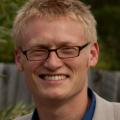This blog post was authored by Safe Routes Partnership research advisor Christina Galardi.
Resource Library
This report assesses the levels of physical activity and sedentary behaviors in American children and youth, facilitators and barriers for physical activity, and related health outcomes.
 Welcome to the new website of the Safe Routes Partnership! The beginning of a new year seems to be the perfect time for a change to the Safe Routes Partnership’s website. The new color scheme, graphics and wonderful photos now reflect the vibrancy and energy of the national Safe Routes to School movement.
Welcome to the new website of the Safe Routes Partnership! The beginning of a new year seems to be the perfect time for a change to the Safe Routes Partnership’s website. The new color scheme, graphics and wonderful photos now reflect the vibrancy and energy of the national Safe Routes to School movement.
 It is an exciting time of new beginnings and opportunity - the beginning of my role as network director, a new blog and a huge expansion of the Safe Routes Partnership.
It is an exciting time of new beginnings and opportunity - the beginning of my role as network director, a new blog and a huge expansion of the Safe Routes Partnership.
 When I was about eight years old I decided to start a lemonade stand. My stand, which was rudimentary in design, included the front steps of my house, a pitcher of watered down lemonade and no cups.
When I was about eight years old I decided to start a lemonade stand. My stand, which was rudimentary in design, included the front steps of my house, a pitcher of watered down lemonade and no cups.
 March has been quite a month for Congressional action on the transportation bill. Unfortunately, it is looking like the momentum will have a tough time carrying over into April.
March has been quite a month for Congressional action on the transportation bill. Unfortunately, it is looking like the momentum will have a tough time carrying over into April.
 In 2008 and 2009 we managed a Safe Routes to School project at five lower income schools around the country, launching and growing Safe Routes to School programs in those five schools for two years.
In 2008 and 2009 we managed a Safe Routes to School project at five lower income schools around the country, launching and growing Safe Routes to School programs in those five schools for two years.
 Both the House and Senate have decided to get down to business on a transportation bill.
Both the House and Senate have decided to get down to business on a transportation bill.
 We love it when Safe Routes to School volunteers and champions share what is happening in their community with us!
We love it when Safe Routes to School volunteers and champions share what is happening in their community with us!
The Indiana Safe Routes to School program is alive and well! Having completed six application rounds since its inception in 2006, there are now 114 infrastructure projects and non-infrastructure activities that have been awarded funding in the Hoosier State. For a map of Indiana’s Safe Routes to School awards click here.
 Safe Routes to School is about walking and bicycling to school and in communities. The Safe Routes to School momentum spreads to players at all levels. There are only three communities with designated Safe Routes to School coordinators in the Greater Washington, DC region.
Safe Routes to School is about walking and bicycling to school and in communities. The Safe Routes to School momentum spreads to players at all levels. There are only three communities with designated Safe Routes to School coordinators in the Greater Washington, DC region.
Since 2017, the Safe Routes Partnership has partnered with community-based organizations, government agencies, and other national partners to improve local park access via walking and biking. In those seven years, we have shown that there is significant demand to unlock the full potential of neighborhood parks for health and community building by activating the routes to them. Along the way, this movement has highlighted the power of engaging parks and recreation stakeholders in creating safer, more equitable streets, ensuring that parks are integral to connected, thriving communities.
 This week, Congress is voting on a new two-year transportation bill, called MAP-21, that will make significant changes to federal transportation policy that negatively impact bicycling and walking programs. Please see our joint statement with the America Bikes coalition for information on the
This week, Congress is voting on a new two-year transportation bill, called MAP-21, that will make significant changes to federal transportation policy that negatively impact bicycling and walking programs. Please see our joint statement with the America Bikes coalition for information on the
 Since Congress released their new MAP-21 Transportation Bill two weeks ago, which eliminated dedicated funding for Safe Routes to School and leaves most of the decision making for active transportation up to states and locals, people have been asking me “what’s next?”
Since Congress released their new MAP-21 Transportation Bill two weeks ago, which eliminated dedicated funding for Safe Routes to School and leaves most of the decision making for active transportation up to states and locals, people have been asking me “what’s next?”

 I have been thinking a lot about how we can ensure Safe Routes to School, walking and bicycling can continue to flourish around the country in our new “MAP-21” world without dedicated funding. So I’ve pulled together a “top 10” list for how Safe Routes to School can survive and thrive.
I have been thinking a lot about how we can ensure Safe Routes to School, walking and bicycling can continue to flourish around the country in our new “MAP-21” world without dedicated funding. So I’ve pulled together a “top 10” list for how Safe Routes to School can survive and thrive.
 It is back to school time in North Carolina and time for an IF/THEN deductive reasoning lesson that will make a difference for all moms, dads and kids heading back to school. Here are three important IF’s and THEN’s
It is back to school time in North Carolina and time for an IF/THEN deductive reasoning lesson that will make a difference for all moms, dads and kids heading back to school. Here are three important IF’s and THEN’s




 Our work to expand the region’s Active Transportation program at the Southern California Association of Governments (SCAG) is progressing.
Our work to expand the region’s Active Transportation program at the Southern California Association of Governments (SCAG) is progressing.